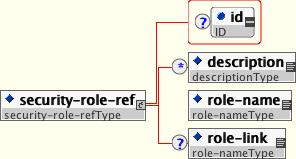Both EJBs and servlets can declare one or more security-role-ref elements as shown in Figure 8.1, “The security-role-ref element”. This element declares that a component is using the role-name value as an argument to the isCallerInRole(String) method. By using the isCallerInRole method, a component can verify whether the caller is in a role that has been declared with a security-role-ref/role-name element. The role-name element value must link to a security-role element through the role-link element. The typical use of isCallerInRole is to perform a security check that cannot be defined by using the role-based method-permissions elements.
Example 8.1, “An ejb-jar.xml descriptor fragment that illustrates the security-role-ref element usage.” shows the use of security-role-ref in an ejb-jar.xml.
<!-- A sample ejb-jar.xml fragment -->
<ejb-jar>
<enterprise-beans>
<session>
<ejb-name>ASessionBean</ejb-name>
...
<security-role-ref>
<role-name>TheRoleICheck</role-name>
<role-link>TheApplicationRole</role-link>
</security-role-ref>
</session>
</enterprise-beans>
...
</ejb-jar>
Example 8.1. An ejb-jar.xml descriptor fragment that illustrates the security-role-ref element usage.
Example 8.2, “An example web.xml descriptor fragment that illustrates the security-role-ref element usage.” shows the use of security-role-ref in a web.xml.
<web-app>
<servlet>
<servlet-name>AServlet</servlet-name>
...
<security-role-ref>
<role-name>TheServletRole</role-name>
<role-link>TheApplicationRole</role-link>
</security-role-ref>
</servlet>
...
</web-app>
Example 8.2. An example web.xml descriptor fragment that illustrates the security-role-ref element usage.
